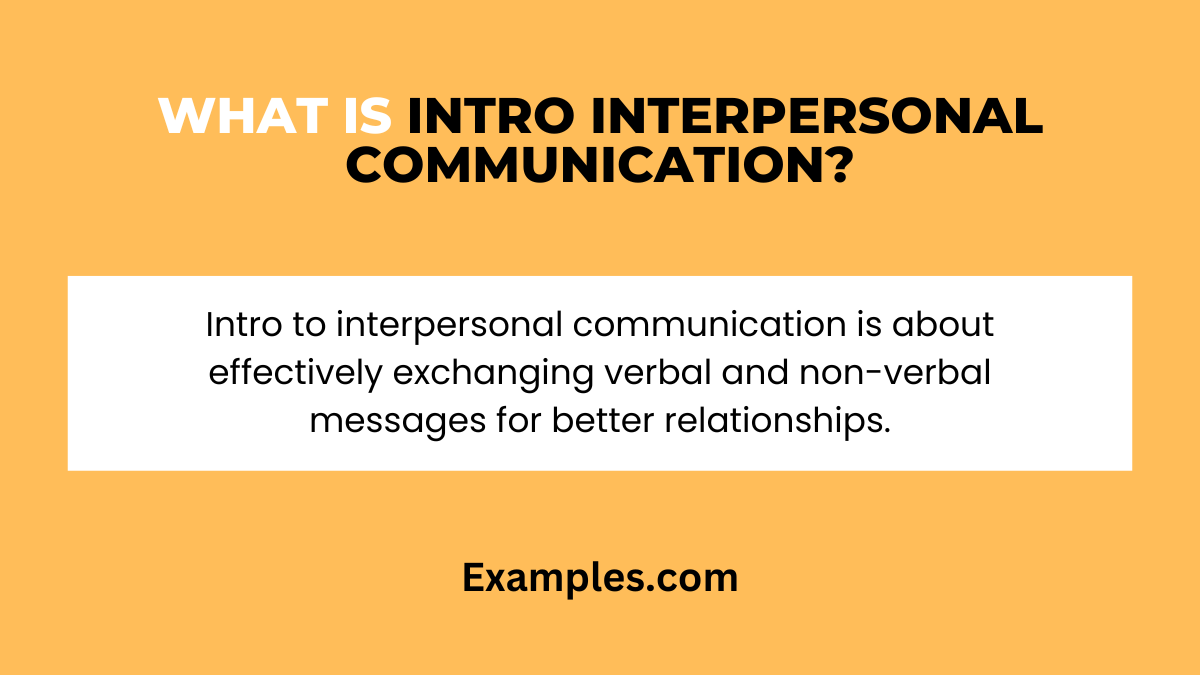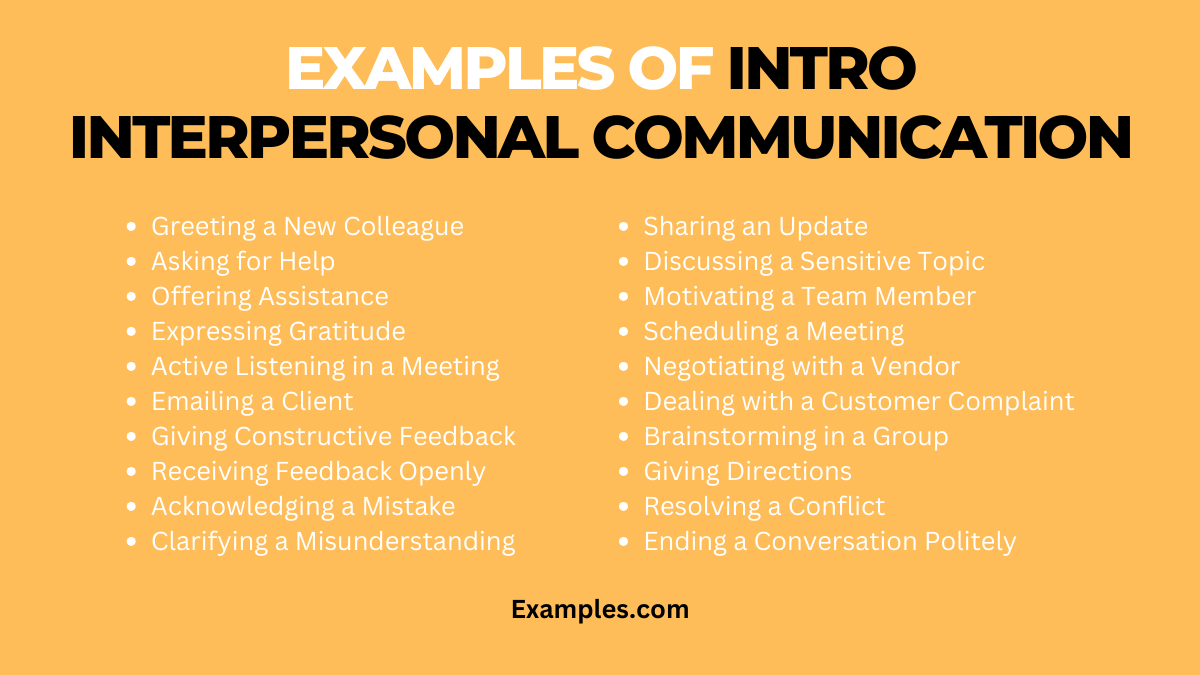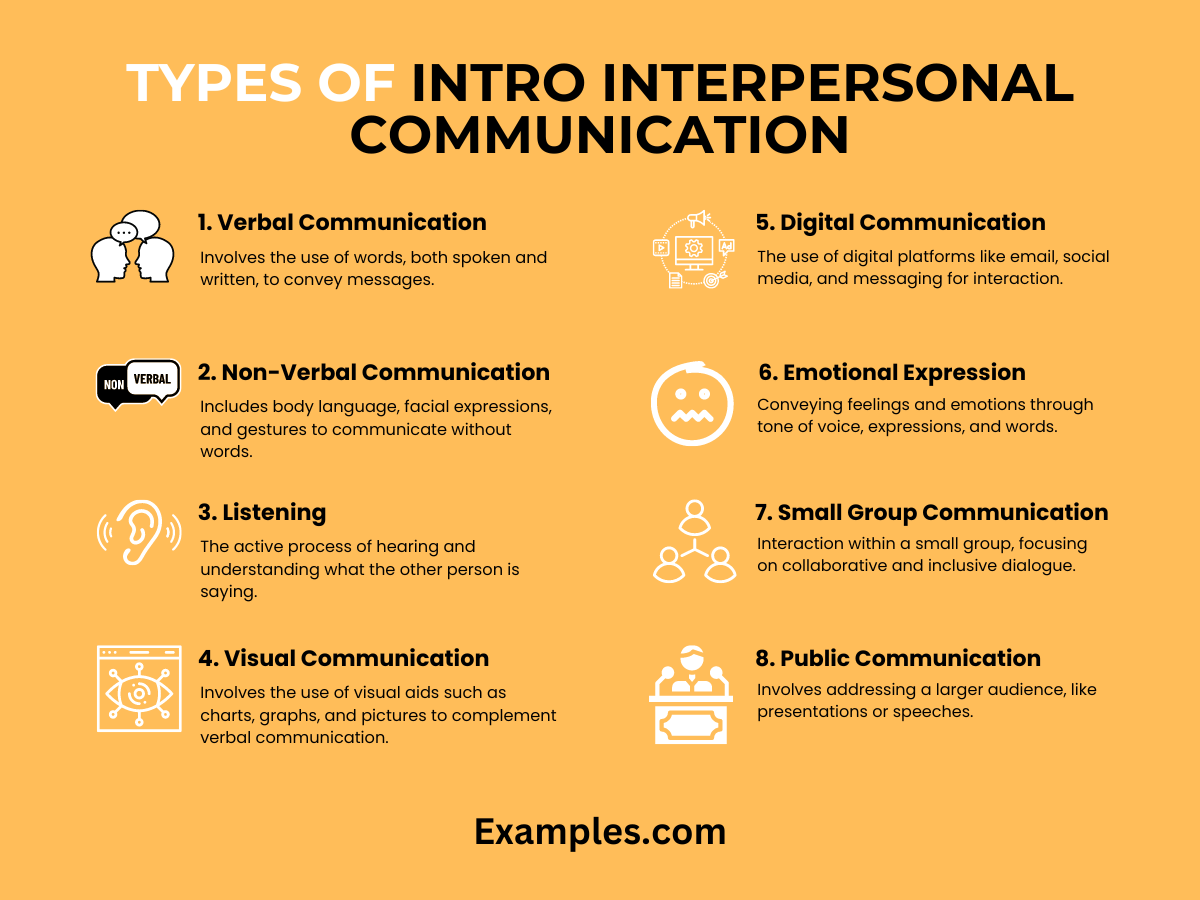20 Intro Interpersonal Communication Examples
Intro to interpersonal communication is a foundational guide for anyone looking to improve their communication skills. It encompasses the basics of oral communication, including understanding and effectively using verbal and non-verbal cues. This introduction aims to equip individuals with the necessary skills to navigate diverse social interactions, enhance personal relationships, and succeed in professional settings. Mastering these skills leads to clearer, more empathetic, and effective communication.
What is Intro Interpersonal Communication?

Intro to interpersonal communication is an essential overview of how individuals exchange information and emotions with others. It focuses on both verbal and non-verbal aspects of communication, teaching how to convey and interpret messages effectively. This foundation is crucial for anyone seeking to develop strong personal and professional relationships, as it lays the groundwork for understanding and improving communication skills in various contexts.
Examples of Intro Interpersonal Communication

Intro to interpersonal communication involves mastering fundamental skills that facilitate effective and empathetic interactions. These examples, encompassing verbal, non-verbal, and written communication, illustrate how to apply these skills in everyday scenarios, enhancing personal and professional relationships.
- Greeting a New Colleague: “Hi, I’m Alex. Great to have you on our team.”
- Asking for Help: “Could you assist me with this report? I value your expertise.”
- Offering Assistance: “I noticed you’re working on the budget. Need any help?”
- Expressing Gratitude: “Thank you for your help today, it really made a difference.”
- Active Listening in a Meeting: “So, if I understand correctly, your main concern is the timeline?”
- Emailing a Client: “Dear Mr. Smith, I’m following up on our earlier discussion about the project.”
- Giving Constructive Feedback: “Your presentation was very informative, but adding some examples might enhance it further.”
- Receiving Feedback Openly: “I appreciate your feedback. It helps me see a different perspective.”
- Acknowledging a Mistake: “I realize I missed the deadline. I apologize and will ensure it doesn’t happen again.”
- Clarifying a Misunderstanding: “I want to clarify what I meant in our last conversation.”

- Sharing an Update: “I’ve completed the analysis. Here are the key findings.”
- Discussing a Sensitive Topic: “I understand this is a delicate matter. Let’s discuss it openly.”
- Motivating a Team Member: “Your hard work is really paying off, keep it up!”
- Scheduling a Meeting: “Are you available for a meeting on Tuesday at 10 am?”
- Negotiating with a Vendor: “I understand your pricing, but let’s find a middle ground that works for both of us.”
- Dealing with a Customer Complaint: “I’m sorry you’re unhappy with our service. Let’s find a solution.”
- Brainstorming in a Group: “Let’s gather some ideas on how to improve our process.”
- Giving Directions: “To complete the task, please follow these steps carefully.”
- Resolving a Conflict: “Let’s discuss this and find a solution that suits both parties.”
- Ending a Conversation Politely: “It was great talking with you. Let’s catch up again soon.”
Types of Intro Interpersonal Communication

| Type | Description |
|---|---|
| Verbal Communication | Involves the use of words, both spoken and written, to convey messages. |
| Non-Verbal Communication | Includes body language, facial expressions, and gestures to communicate without words. |
| Listening | The active process of hearing and understanding what the other person is saying. |
| Visual Communication | Involves the use of visual aids such as charts, graphs, and pictures to complement verbal communication. |
| Digital Communication | The use of digital platforms like email, social media, and messaging for interaction. |
| Emotional Expression | Conveying feelings and emotions through tone of voice, expressions, and words. |
| Small Group Communication | Interaction within a small group, focusing on collaborative and inclusive dialogue. |
| Public Communication | Involves addressing a larger audience, like presentations or speeches. |
| Written Communication | Communicating through written texts, including letters, emails, and reports. |
| Feedback Exchange | Providing and receiving feedback to improve understanding and performance. |
Each type of intro interpersonal communication plays a distinct role in how effectively we connect with and understand others, making them all essential components of comprehensive communication skills.
Skills of Intro Interpersonal Communication
Mastering the skills of intro interpersonal communication is crucial for effective interaction in both personal and professional contexts. These skills encompass a range of abilities that facilitate clear and empathetic exchanges.
- Active Listening: Essential for understanding others, it involves fully focusing on the speaker, comprehending their message, and responding thoughtfully.
- Verbal Communication: The ability to clearly articulate thoughts and information using language, ensuring the message is understood as intended.
- Non-Verbal Communication: This includes interpreting and using body language, facial expressions, and gestures to convey and understand messages without words.
- Emotional Intelligence: Recognizing and managing one’s own emotions and understanding those of others to communicate effectively.
- Feedback Giving: The skill of providing constructive feedback that is clear, specific, and helpful in a respectful manner.
- Empathy: The ability to understand and share the feelings of others, crucial for building rapport and trust.
- Conflict Resolution: Effectively addressing and resolving disagreements or misunderstandings through communication.
- Assertiveness: Communicating one’s needs, opinions, and feelings confidently and respectfully.
- Adaptability: The ability to adjust communication styles to suit different people and situations.
- Clarity and Conciseness: Being able to express thoughts and information clearly and succinctly, avoiding misunderstandings.
Understanding the basics of interpersonal communication is the first step toward effective interaction. This guide and its tips serve as a foundation for improving your communication skills. Whether in personal or professional settings, mastering these principles will enhance your ability to connect, convey ideas, and build meaningful relationships. Embracing these fundamentals opens the door to successful and fulfilling interactions.



